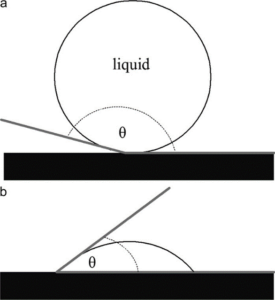Wettability enhancement can improve the lubrication conditions by forming the tribofilm on the surface, reducing wear rate and friction coefficient[1];one of the way is by grafting hydrophilic acrylic acid on UHMWPE. The presence of carboxylic groups in the acrylic acid enhances the interaction with the bioactive molecules such as proteins, peptides, etc. With the grafting ratio of 5.5% , the water contact angle reduced from 83o to 35o due to the great polarity and affinity for water by the carboxyl group present in the acrylic acid. As the surface wettability improves with the graft ratio, the tensile strength decreases while the wear rate declines initially and starts to rise again. Another study done by the Lu et al.[2] on ultrasonically infiltrated with GO mixed with UHMWPE significantly changed the wettability. The surface wettability increased with the increase of ultrasound-induced time resulted in the reduction of COF and wear rate. There are various studies suggesting the improvement in the tribological properties with the enhancement of surface wettability. However, the tribological properties does depend on other various factors such as sliding speed, surface topography, materials properties, sliding temperature, applied load and pressure etc.

Wettability properties can be measured by different methods such as contact angle measurements and Wilhelmy plate method. Understanding the wettability properties of a material can be useful in controlling the tribological behavior and the biocompatibility of a material in biotribological applications.
References:
[1] Y. Deng, D. Xiong, and K. Wang, “Biotribological properties of UHMWPE grafted with AA under lubrication as artificial joint,” J Mater Sci Mater Med, vol. 24, no. 9, pp. 2085–2091, Sep. 2013, doi: 10.1007/s10856-013-4970-x.
[2] P. Lu, M. Wu, X. Liu, X. Ye, W. Duan, and X. Miao, “Surface modification and biotribological behavior of UHMWPE nanocomposites with GO infiltrated by ultrasonic induction,” J Biomed Mater Res B Appl Biomater, vol. 109, no. 6, pp. 808–817, Jun. 2021, doi: 10.1002/JBM.B.34746

This article was written by Dilesh Raj Shrestha as part of an ongoing series of scientific communications written and curated by BioTrib’s Early Stage Researchers.
Dilesh is researching the Development of 3D-printable, self-lubricated polymer composites with improved wear resistance for total joint replacement at Luleå University of Technology, Sweden.
